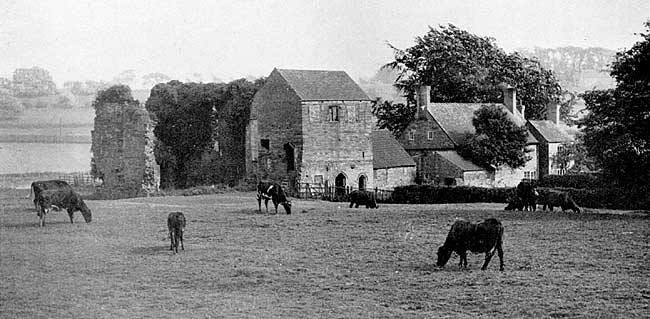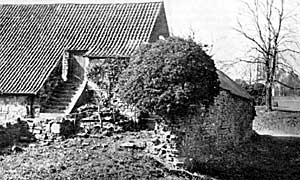BEAUVALE.
By The Rev. A. Du Boulay Hill.

Beauvale Priory in the 1930s.
The Priory of Beauvale, founded 1343, was the third in point of time of the nine houses of the Carthusian order which were established in England. It was a small house, for a prior and twelve monks.
Though there is but little remaining above ground, the whole area has been so little interfered with that it would probably be possible to recover the whole plan with a little judicious digging, for comparison with the very complete plan of the Priory of Mount Grace, in Yorkshire, founded about flfty-flve years later. This would be a splendid piece of research for the Thoroton Society to undertake.
Two fragments of the side walls of the church are standing nearly to their full height. The church was 26ft. in width. A length of 20ft. of the north wall, with a wall at right angles projecting outside, and a low recessed arch on its inner face, terminates in the jamb of a doorway at its western end. About 60ft. of the south wall remains, with a small portion of its south-west angle still shewing the jamb of a large west window. In this south wall, there is a three-light Perpendicular window which has lost its tracery, and a doorway. A curious block of buildings stands against the south-west angle of the church, running southwards, containing two small vaulted chambers below, and a vice in its south-west corner. The upper storey of this block is of later date, but probably previous to the suppression.
On the south wall of the church was a cloister court with a pentise roof against the wall of the church, the marks of which are visible below the window cill. A considerable extent of the north wall of this court remains, now forming a retaining wall against the debris outside it, and shewing the entrance doors perhaps to the chapter house, and monks' cells, and a recess for a lavatory. The south side of the court is formed by the block of buildings previously mentioned, which was entered by an arch from the north alley, and by the present farm house which appears to have incorporated some original buildings. There is a well towards the southern end of the cloister space. A curious stone trough, 4ft. 9ins. x 2ft. x 1ft. 5ins., divided into two parts by a half partition, may prove to be one of the "turns" througli which food was passed into the monks' cells.
At some distance from the church stands nearly the whole length of the eastern precinct wall, with some ancient buildings, now turned into farm sheds, at its south-east angle. In the meadow to the north and west of the church, there are mounds indicating the presence of foundations, which would probably reveal the position of monks' cells and gardens in a great cloister on the west.
At the Manor Farm, on the opposite side of the valley, there are two old pieces of glass in one of the windows. Each figure has a nimbus ; one figure bears a feather or palm in her left hand and a sword pierces her neck ; it may represent St. Euphemia or St. Agatha.
The other carries a pair of tongs in her hand, which hold a tooth (?) and may represent St. Apollonia.
The party proceeded by way of Greasley, where St. Mary's Church occupies a prominent position by the wayside, but with few houses near it. Until some seventy years ago, it served a very considerable district, comprising the parishes of Kimberley, Brinsley, Nevvthorpe, Watnall Cantelupe, Watnall Chaworth, Moorgreen, and Hempshall. No stop was made here, as there is nothing of much interest in the church beyond a few monuments to members of the Rolleston family, and a small brass plate on the cill of one of the chancel windows bearing the following inscription, which it may be well to put on record:—Hic jacet Helena qui fuit uxor Rici Bingham militis qudam unus justiciarum de Banco dni Regis qui obiit xii die mensis ffebruarii a° dni Millium ccccxlviii Cui aie ppiciet deus an. There is a brass shield beside it, but the arms are quite worn off. Ralph Rolleston, second son of James Rolleston, Esq., of Lea, co. Derby, married, in the time of Queen Elizabeth, Margaret, elder daughter and co-heir of Sir Richard Bingham, of Watnall Chaworth, by Anne, his wife, sister and co-heir of Sir Nicholas Strelley, of Linby, and thus acquired the manor of Watnall Chaworth, which has ever since continued to be the seat and property of the Rolleston family.

Greasley Castle in the 1920s.
A few hundred yards beyond the church, on the same side of the road, is the site of Greasley Castle. This was the stronghold of the de Cantelupe family from ancient days, for Nicholas de Cantelupe held a Knight's fee here so long ago as the reign of Henry III. King Edward III. allowed another Nicholas de Cantelupe to "strengthen and fortify his mansion House and embattle it; from this time it was called a Castle" (Thoroton's History). It was this same Nicholas who founded Beauvale in his park in 1343. The dry moat and wall with remains of corner towers is all that now survives.
Turning sharply to the left from the main road at the entrance of the village of Watnall, the road was taken for Bulwell Wood Hall, a former home of the Byron family. It was rebuilt in the reign of Charles I., by the Hon. Wm. Byron, eldest son of the second Lord Byron, the valiant supporter of that King, by whom he was knighted at the battle of Edge Hill. The Hall was purchased a little more than a century ago by the then Duke of Portland, six rooms of which were destroyed by fire 150 years ago; it is now occupied as a farm house. There is a tradition that this Hon. William Byron had a daughter, who secretly married one of her father's keepers, and that the "White Lady," who is said to have haunted the grounds at Newstead, sprang from this ill assorted match. There was at one time a picture here of a favourite grey horse belonging to the fifth Lord Byron, on which, it is said, he rode after his trial in Westminster Hall (1765), for killing Mr. William Chaworth in a duel, to this house without drawing rein, and whose back he broke on that occasion in forcing his tired favourite to leap the park gates (Black's Guide, edited by A. E. Lawson Lowe). "Bulwell Wood was said to be one of the seven tracts of woodland within or on the borders of the forest, which were not attached to any town or parish and paid no tithes " (Bailey's Annals of Notts., p. 179). It was granted, with Newstead Priory, to the Byron family, 28 May, 1540. Bailey calls the house "a curious specimen of the ponderous style of architecture which prevailed in the days of its erection," but its graceful stone gables were admired by many of the visitors on this occasion. There is a stone in the cellar dated September, 1584. C R.
Hucknall Torkard was shortly reached, where the following paper was read in the church by Mr. J. H. Beardsmore, to whom the party is further indebted for the very complete arrangements made on the occasion of the visit.
